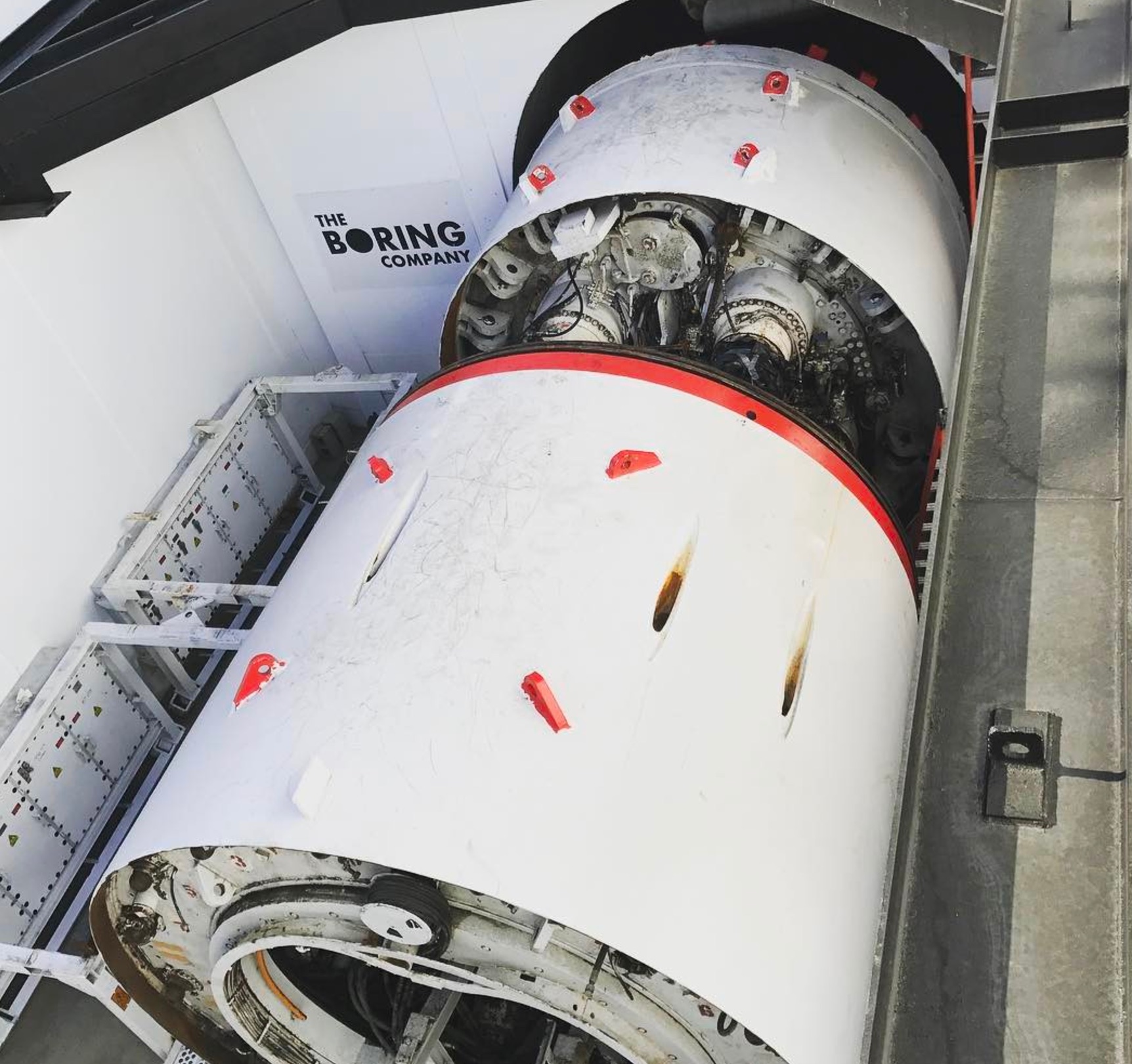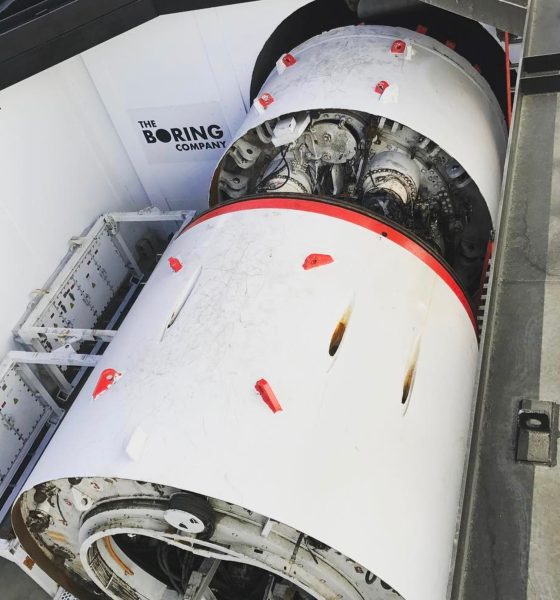

News
Elon Musk’s The Boring Company gets permit to dig in Washington, D.C.
Elon Musk’s tunneling firm, The Boring Company, has received an early excavation permit from the local D.C. government to start digging at Lot 53 New York Avenue in Washington, D.C. Once completed, the NY Ave. location could be key in the NY-Phil-Balt-D.C. Hyperloop, a system of tunnels that would enable commuters to travel from New York to Washington in just 29 minutes.
A Boring Company spokesperson noted that the New York Avenue location could become one of the underground system’s first “stations,” where passengers can access the underground system. The spokesperson asserted, however, that stations in the Hyperloop system would be designed in a different way than conventional train or subway stations.
“A New York Avenue location, if constructed, could become a station as part of the Hyperloop network of ultra-high-speed main lines and slower city loops. Stations in a Loop or Hyperloop system are small in size and widely distributed in a network. That’s very different from large-station terminals considered for train systems,” the Boring Company spokesperson told the WaPo.
The Boring Company would be working with an unnamed partner for its operations in the New York Avenue location, though there is a good chance that the startup would be working with Hyperloop One, a Los Angeles, CA company working to commercialize hyperloop technology, according to an Engadget report.
D.C. Mayor Muriel E. Bowser’s chief of staff John Falcicchio further stated that the local government is open to new ideas that could revolutionize private and public transportation. The chief-of-staff, however, noted that the mayor’s office is still in the process of gaining an understanding of Hyperloop’s technology and its implications for the commuting public.
“We’re just beginning, in the mayor’s office, our conversation to get an understanding of what the general vision is for Hyperloop. We’re open to the concept of moving people around the region more efficiently,” Falcicchio said, according to the Washington Post.
The SpaceX and Tesla CEO’s tunneling company has been approaching its efforts on numerous fronts, with the firm attempting to secure permits from local governments both on the east and west coast. While its permit from the D.C. government is a significant step forward in the Elon Musk-led firm’s tunneling initiatives, the company has been met with resistance from local officials on both sides of the United States.
As noted in a previous report, Maryland Assistant Attorney General David Stamper voiced his opposition to the digging permit granted to the Boring Company by the State Highway Administration last year. According to Stamper, the SHA was not within its rights when it gave the tunneling startup the go-signal to start its operations last October, considering that the tunnels would be transporting people, cars, and cargo.
Apart from this, The Boring Co.’s presentation and proposal to the city council of Culver City also ended in a stalemate, after lawmakers and residents aired their opposition and reservations about the startup’s tunneling project. The Culver City meeting concluded with the city council ultimately voting to hire consultants who could assess the overall feasibility, risks, and benefits of the Elon Musk-led tunneling startup’s initiatives before it can make a final decision.

Elon Musk
Elon Musk confirms xAI’s purchase of five 380 MW natural gas turbines
The deal, which was confirmed by Musk on X, highlights xAI’s effort to aggressively scale its operations.

xAI, Elon Musk’s artificial intelligence startup, has purchased five additional 380 MW natural gas turbines from South Korea’s Doosan Enerbility to power its growing supercomputer clusters.
The deal, which was confirmed by Musk on X, highlights xAI’s effort to aggressively scale its operations.
xAI’s turbine deal details
News of xAI’s new turbines was shared on social media platform X, with user @SemiAnalysis_ stating that the turbines were produced by South Korea’s Doosan Enerbility. As noted in an Asian Business Daily report, Doosan Enerbility announced last October that it signed a contract to supply two 380 MW gas turbines for a major U.S. tech company. Doosan later noted in December that it secured an order for three more 380 MW gas turbines.
As per the X user, the gas turbines would power an additional 600,000+ GB200 NVL72 equivalent size cluster. This should make xAI’s facilities among the largest in the world. In a reply, Elon Musk confirmed that xAI did purchase the turbines. “True,” Musk wrote in a post on X.
xAI’s ambitions
Recent reports have indicated that xAI closed an upsized $20 billion Series E funding round, exceeding the initial $15 billion target to fuel rapid infrastructure scaling and AI product development. The funding, as per the AI startup, “will accelerate our world-leading infrastructure buildout, enable the rapid development and deployment of transformative AI products.”
The company also teased the rollout of its upcoming frontier AI model. “Looking ahead, Grok 5 is currently in training, and we are focused on launching innovative new consumer and enterprise products that harness the power of Grok, Colossus, and 𝕏 to transform how we live, work, and play,” xAI wrote in a post on its website.
Elon Musk
Elon Musk’s xAI closes upsized $20B Series E funding round
xAI announced the investment round in a post on its official website.

xAI has closed an upsized $20 billion Series E funding round, exceeding the initial $15 billion target to fuel rapid infrastructure scaling and AI product development.
xAI announced the investment round in a post on its official website.
A $20 billion Series E round
As noted by the artificial intelligence startup in its post, the Series E funding round attracted a diverse group of investors, including Valor Equity Partners, Stepstone Group, Fidelity Management & Research Company, Qatar Investment Authority, MGX, and Baron Capital Group, among others.
Strategic partners NVIDIA and Cisco Investments also continued support for building the world’s largest GPU clusters.
As xAI stated, “This financing will accelerate our world-leading infrastructure buildout, enable the rapid development and deployment of transformative AI products reaching billions of users, and fuel groundbreaking research advancing xAI’s core mission: Understanding the Universe.”
xAI’s core mission
Th Series E funding builds on xAI’s previous rounds, powering Grok advancements and massive compute expansions like the Memphis supercluster. The upsized demand reflects growing recognition of xAI’s potential in frontier AI.
xAI also highlighted several of its breakthroughs in 2025, from the buildout of Colossus I and II, which ended with over 1 million H100 GPU equivalents, and the rollout of the Grok 4 Series, Grok Voice, and Grok Imagine, among others. The company also confirmed that work is already underway to train the flagship large language model’s next iteration, Grok 5.
“Looking ahead, Grok 5 is currently in training, and we are focused on launching innovative new consumer and enterprise products that harness the power of Grok, Colossus, and 𝕏 to transform how we live, work, and play,” xAI wrote.
Investor's Corner
Tesla gets price target bump, citing growing lead in self-driving

Tesla (NASDAQ: TSLA) stock received a price target update from Pierre Ferragu of Wall Street firm New Street Research, citing the company’s growing lead in self-driving and autonomy.
On Tuesday, Ferragu bumped his price target from $520 to $600, stating that the consensus from the Consumer Electronics Show in Las Vegas was that Tesla’s lead in autonomy has been sustained, is growing, and sits at a multiple-year lead over its competitors.
CES 2026 validates Tesla’s FSD strategy, but there’s a big lag for rivals: analyst
“The signal from Vegas is loud and clear,” the analyst writes. “The industry isn’t catching up to Tesla; it is actively validating Tesla’s strategy…just with a 12-year lag.”
The note shows that the company’s prowess in vehicle autonomy is being solidified by lagging competitors that claim to have the best method. The only problem is that Tesla’s Vision-based approach, which it adopted back in 2022 with the Model 3 and Model Y initially, has been proven to be more effective than competitors’ approach, which utilizes other technology, such as LiDAR and sensors.
Currently, Tesla shares are sitting at around $433, as the company’s stock price closed at $432.96 on Tuesday afternoon.
Ferragu’s consensus on Tesla shares echoes that of other Wall Street analysts who are bullish on the company’s stock and position within the AI, autonomy, and robotics sector.
Dan Ives of Wedbush wrote in a note in mid-December that he anticipates Tesla having a massive 2026, and could reach a $3 trillion valuation this year, especially with the “AI chapter” taking hold of the narrative at the company.
Ives also said that the big step in the right direction for Tesla will be initiating production of the Cybercab, as well as expanding on the Robotaxi program through the next 12 months:
“…as full-scale volume production begins with the autonomous and robotics roadmap…The company has started to test the all-important Cybercab in Austin over the past few weeks, which is an incremental step towards launching in 2026 with important volume production of Cybercabs starting in April/May, which remains the golden goose in unlocking TSLA’s AI valuation.”
Tesla analyst breaks down delivery report: ‘A step in the right direction’
Tesla has transitioned from an automaker to a full-fledged AI company, and its Robotaxi and Cybercab programs, fueled by the Full Self-Driving suite, are leading the charge moving forward. In 2026, there are major goals the company has outlined. The first is removing Safety Drivers from vehicles in Austin, Texas, one of the areas where it operates a ride-hailing service within the U.S.
Ultimately, Tesla will aim to launch a Level 5 autonomy suite to the public in the coming years.








